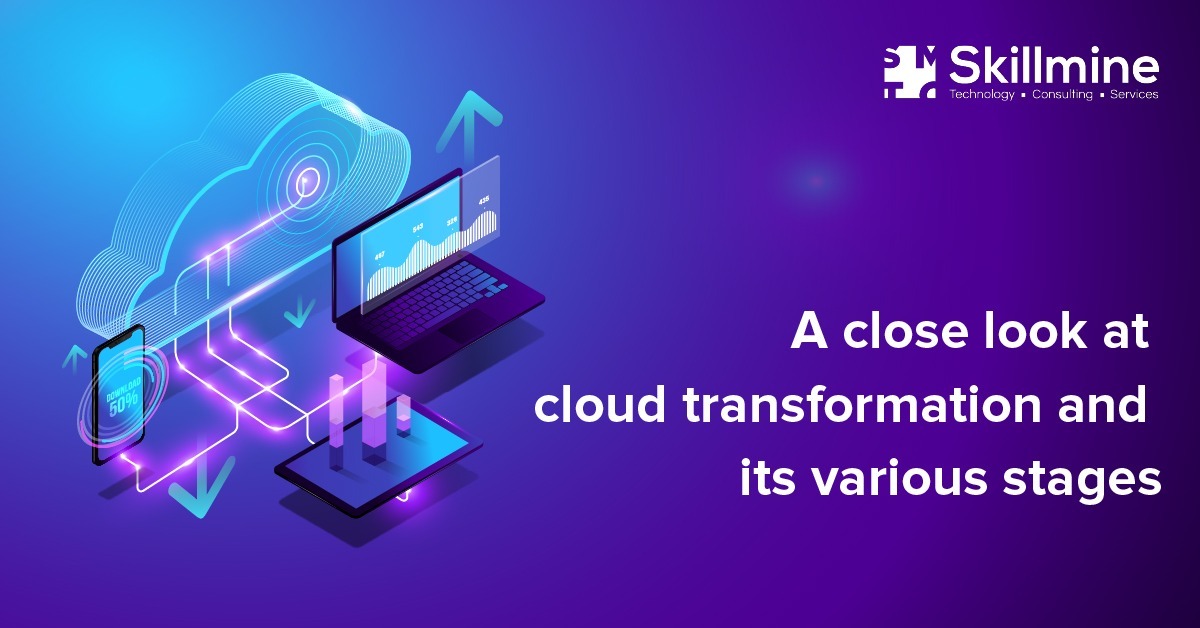IT infrastructures have changed to support the way people demand to work, from mainframe to client-server to the web to cloud. In a way, everything ancient has a new lease on life. Modern cloud computing technology shares many similarities with mainframe design, such as the ability to connect remotely. But the cloud is much more highly distributed, scalable, and resilient.
The cloud is no longer a testbed for IT innovation, but rather an operational requirement for businesses of all kinds. There are four stages to a typical cloud transformation project. These phases must be applied depending on an organization’s present transformation stage, including Assessment of Strategy and Portfolio, Planning and Design, Migration, Transformation, Management, and Optimization of Operations.
Assessment of Strategy and Portfolio
The goal of this phase is to examine the organization’s cloud readiness, create a cloud strategy, review the application portfolio, and determine the target disposition. It’s critical to understand the organization’s present business objectives and priorities, current IT landscape, ongoing transformation activities, and technological strategies before deciding on a cloud strategy.
In this phase, the company should define cloud goals that are in line with its vision, business strategy, and IT plan. Define how the cloud will help the company achieve its business goals or add new capabilities, the major goals of cloud adoption, KPI measurements for these aims that have both tangible and intangible advantages, and the cloud migration and transformation process technique.
Assessment of the Portfolio of Applications:
Assess the application portfolio throughout the entire organization. This is necessary for developing a company-wide transformation strategy. If such an experiment has previously been completed, use the artifacts for additional study. If the entire organization isn’t ready for the cloud, undertake an assessment of apps from business units that are ready.
Both top-down and bottom-up approaches must be used to evaluate applications. This phase entails organizing workshops and obtaining responses to a series of questionnaires from various application stakeholders to acquire required application details. The configuration management database (CMDB) or current Enterprise Architecture (EA) repositories can also be used to aggregate application and infrastructure information. It’s all about “understanding an organization’s current IT estate.”
Migration and transformation:
Follow the 7R strategy for migration- Rehost, Replatform, Refactor, Rearchitect, Replace, Retain, and Retire are some of the options. (Follow the 7 Steps of cloud migration) It can be helpful to include a high-level suggestion summary for the applications at this point. Define the short- and long-term recommendations for each application, for example, the short-term plan could be to ‘Rehost,’ while the long-term approach could be to rearchitect using a server-less compute sample disposition like this one. The assessment process should result in one of the 7R methods being mapped to applications.
Optimization of operations:
The “Manage and Optimize” stage focuses on post-cloud migration infrastructure, applications, and data management (“RUN”).Conduct a high-level cost-benefit analysis for applications when the high-level assessment is completed. Calculate the total current run cost of the application using the on-premise infrastructure run cost, depreciation, and infrastructure operations costs. Determine the application’s run cost on the target cloud for the next 3 to 4 years. Calculate the estimated migration costs. Calculate the cost reductions in current infrastructure operating if you switch to the cloud. To arrive at the goal cost, take advantage of various cloud provider discounts and long-term pricing plan perks.
Organizations can use cloud transformation Services techniques to move their data to cloud environments. It can be scaled up or down depending on the demands of the company. A well-defined cloud transformation strategy is intended to achieve company objectives, cost savings, and strategic advantages.
Benefits of Cloud Transformation
Enhanced Operational Efficiency
In today’s digital landscape, accessing vital information from any location at any time is increasingly expected. Cloud transformation services facilitate seamless data retrieval, fostering real-time collaboration and communication while enhancing analytics through the dissolution of data silos. Moreover, cloud infrastructure alleviates the burden of routine maintenance tasks, enabling IT professionals to concentrate on driving innovation within the company.
Improved Adaptability, Scalability, and Velocity
Remaining competitive in today’s swiftly changing market necessitates cloud transformation for many businesses. Cloud transformation services offer rapid scalability, swiftly accommodating new priorities or projects, setting apart cloud-based enterprises from their on-premises counterparts, which may encounter lengthy delays in upgrading IT infrastructure.
Heightened Data Security
Transitioning data to the cloud raises concerns about security for many organizations. However, contrary to intuition, cloud migration often strengthens data protection. By employing robust security protocols such as encryption and multi-layered defenses, cloud hosting mitigates the risk of unauthorized access by cybercriminals. Additionally, redundant data backups provided by cloud services minimize the likelihood of data loss or costly downtime in the face of a disaster.
Optimized Cost Management
Enterprise cloud transformation services offer a more efficient cost structure by eliminating upfront capital expenditures associated with purchasing and maintaining physical infrastructure. Pay-as-you-go models allow businesses to scale resources according to demand, minimizing wastage and optimizing expenditure. Furthermore, reduced labor and maintenance requirements free up IT personnel to focus on strategic organizational objectives.
Various industries are anticipated to experience varying advantages from adopting cloud technology. At the top tier of the value capture spectrum are high-tech, retail, and healthcare sectors. Occupying the middle ground are electronics and semiconductors, consumer-packaged goods, and media enterprises. Meanwhile, materials, chemicals, and infrastructure organizations are situated at the lower end of the continuum.
Looking for expert technology consulting services? Contact us today.





